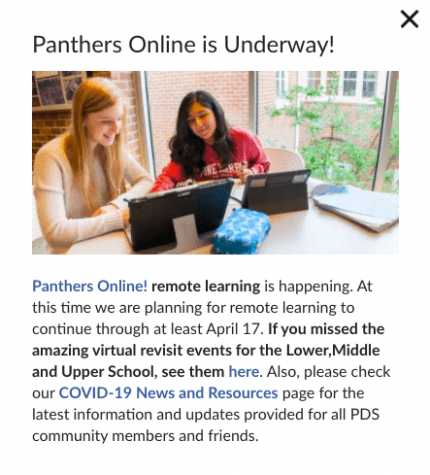An Update on Distance Learning at Princeton Day School
April 14, 2020
This Tuesday, Head of School Paul Stellato sent an email to the parents of those attending Princeton Day, declaring that remote learning will be extended through May 15.
On Monday, March 30, PDS students in all three divisions began online learning, in light of concerns regarding COVID-19, to preserve the health of the PDS community. “Leadership and faculty anticipated this move before spring break,” said Head of Upper School Trixie Sabundayo. Ms. Sabundayo elaborated, “We began faculty training the week before break began. By the first few days of Spring Break, faculty and staff were deep in the planning stages of our remote learning program.” Students received the news during their break and began to prepare for an online curriculum.
One of the biggest differences between remote learning and the normal school schedule is the switch to asynchronous classes. Teachers post classwork instructions, and students complete their work on their own time, before an eight PM deadline. When deciding how school would continue virtually, a few factors came into consideration. For example, many problems were found with the synchronous learning approach. Such a system is very reliant on technology, and glitches or crashes would have significantly larger effects early in remote learning than the Schoology crashes the Upper School has been experiencing in terms of an asynchronous approach.

Princeton Day School’s Website displayed this announcement on its homepage the day the announcement was made. (Photo/PDS)
In addition, Upper School History Teacher and future Acting Head of Upper School Chris Rhodes explained that “due to various developmental and technological issues, real-time, class-wide engagement is very hard to create on the screen.” This decision to go asynchronous was therefore made after considering the methods adopted by schools on the West Coast and in other circumstances. Ms. Sabundayo remarked, “We took our lead from best practices and certainly from the experiences of other schools…we had the great luck of being in the position to learn from their experiences (and missteps).” However, platforms such as Google Meet are still being used for advisory and class meetings, and to create “meaningful synchronous moments in the school day for students,” as stated by Ms. Sabundayo. The administration is constantly asking for and receiving feedback from the larger PDS community. There has been an interest in more synchronous meetings and classes, and these requests will be taken into consideration as the remote learning plan continues to evolve and improve.
Because there is no longer any face-to-face interaction, students and teachers alike have had to make the transition into a primarily technology-centered system of learning. Upper School History Teacher and Technology Coordinator Lauren Ledley spoke about some of the programs used to make remote learning possible. Like many schools, PDS is utilizing video calls as a way for students and teachers to connect. “Adopting Google Meet as our video conferencing tool was also new territory,” Ms. Ledley noted, “Thankfully, Meet is easy to use within our Google ecosystem, but there is still a learning curve for many faculty and students.” When asked for advice about managing the technology, Ms. Ledley emphasized eliminating distractions as a strategy for the efficient use of this resource. “My biggest tip about using tech efficiently during remote learning is to remember that our brains CANNOT multitask. The idea of productive multitasking is a myth,” Ms. Ledley suggested.
If we keep this in mind, we are sure to find success with this new semi-synchronous system and continue to learn and connect during these changing times.
In his latest update, Mr. Stellato specified that the school would work to transition into synchronous learning. Though this might be difficult, he will work to guarantee “that no semester grade will be lower than that of the mid-term grade,” and that teachers will attempt to “afford every student the opportunity to raise his/her grades from those of the mid-term. Only time will tell if PDS will overcome the struggles that remote learning brings, but in the meantime, students can look forward to the possibility of seeing their friends in May.
